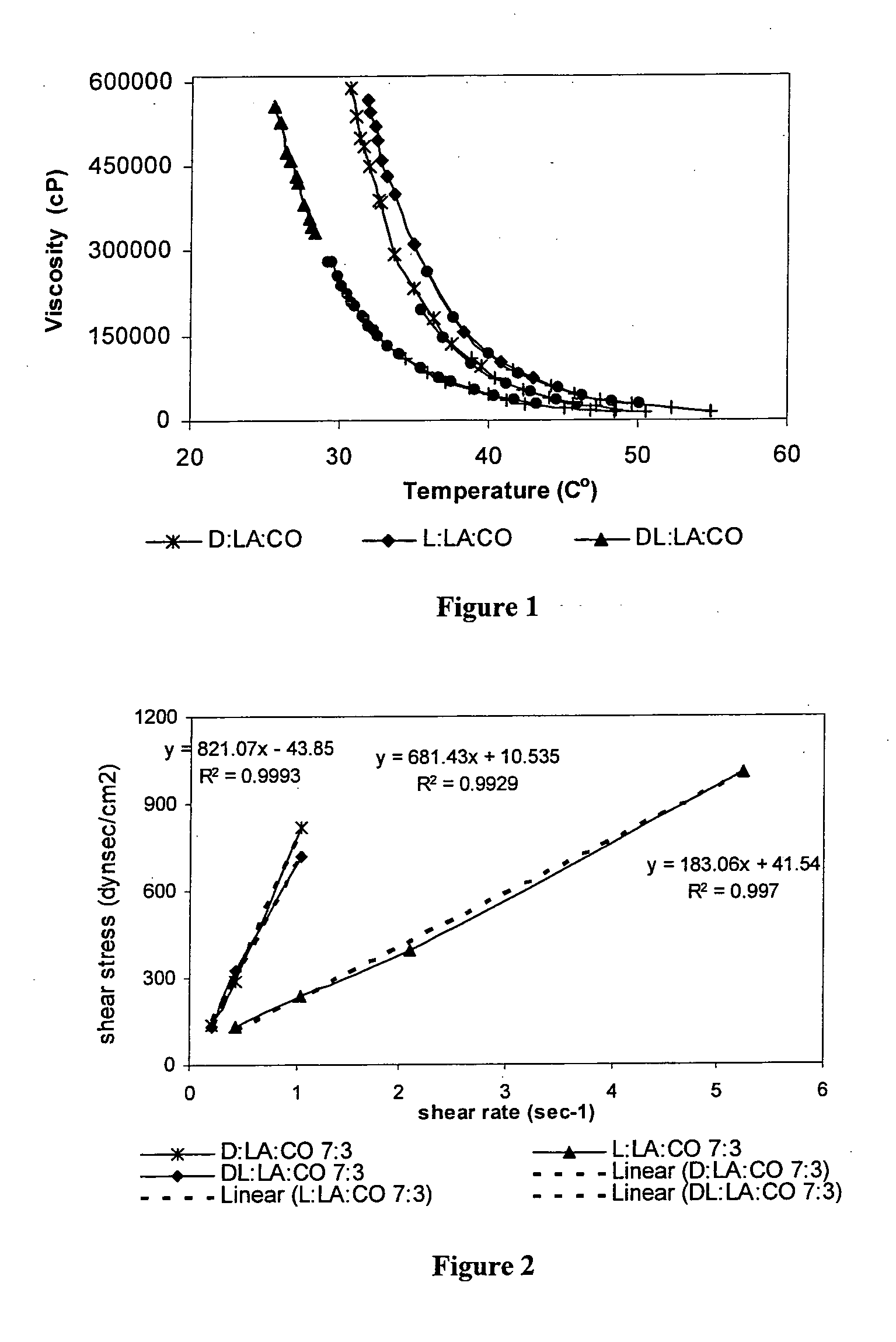Injectable biodegradable polymer compositions for soft tissue repair and augmentation
a biodegradable, polymer technology, applied in the field of polymer compositions, can solve the problems of no material appears to be completely safe and effective, no material can solve the problems of skin damage, acne, surgical scarring or aging, and the cosmetics of facial defects, so as to improve the cosmetics and aesthetics of the skin, improve the cosmetics, and enhance the growth of the tissue.
- Summary
- Abstract
- Description
- Claims
- Application Information
AI Technical Summary
Benefits of technology
Problems solved by technology
Method used
Image
Examples
example 1
Synthesis of Vernonia Oil Based Polyesters
[0098]Vernonia oil (Ver-Tech, Inc., Bethesda, Md.) containing an average of 2.1 epoxy functionalities per molecule was used in this study.
[0099]Opening of Epoxy Group
[0100]The reaction was conducted using a single neck reaction vessel equipped with a mechanical stirrer and heated using an oil bath. Vernonia oil has an average of 2.1 epoxy groups per molecule. The lactic acid was calculated at a 1:1 molar ratio to the epoxy groups. The reaction mixture was heated to 120° C. and reaction was stirred for 12 h. The reaction was monitored by NMR and IR to confirm the disappearance of the epoxy groups.
[0101]Polymer Synthesis by Polycondensation
[0102]The polyesters were synthesized using a single neck reaction vessel equipped with a mechanical stirrer and heated using an oil bath. Modified vernonia oil and lactic acid were added into the vessel with different weight / weight ratios (lactic acid used for the ring opening step was included in the total...
example 2
Synthesis and Characterization of Injectable Castor Oil Based Polyesters
[0110]Materials
[0111]Castor oil was purchased from Floris (Israel). Ricinoleic acid (98% pure) was prepared by hydrolysis of castor oil and further purified by extraction with an aqueous solution, for example sodium chloride solution or carbonate solution, to remove hydrophilic contaminants. L-lactic acid (L-LA) and DL-lactic acid (DL-LA) were purchased from J. T. Baker (Deventer, The Netherlands). D-lactic acid was prepared from the hydrolysis of D-lactide in water. D-lactide was purchased from Purac Biochem (Gorinchem, The Netherlands). CDCl3, for NMR, was purchased from Sigma-Aldrich (Rehovot, Israel). All solvents and salts were analytical grade from Aldrich or Biolab (Jerusalem, Israel).
[0112]Instrumentation
[0113]IR spectra were performed on monomer and polymer samples cast on NaCl plates from CH2Cl2 solutions on Bruker (Vector 22 System FT-IR). UV spectra were taken on a Kontron Instruments Uvicon model 93...
example 3
Biocompatibility, Biodegradation and Elimination of p(SA:RA) 3:7 in Rats
[0144]Objective
[0145]The goal of this study was to examine the systemic and local effects of biodegradable poly(ester-co-anhydrides) and polyesters implanted in rats for a period of 6 weeks and to examine the degradation behavior of the polymer matrix from the implantation site.
[0146]Methods
[0147]The following polymers were chosen for the study: poly(sebacic-co-ricinoleic acid) 3:7 (PRASA), poly(caprolactone-castor oil) 1:1 (PCLCO) and poly(lactic acid-castor oil) 1:1 (PLACO). All polymers were easily injectable through a 27 gauge needle. The polymers were synthesized by melt condensation and had a weight average molecular weight (Mw) of 4,000.
[0148]Animals: Female Spraque-Dawley (SD) rats were obtained from Harlan Laboratories (Jerusalem, Israel). The rats' weight at implantation was 210±15.0 g. The rats were housed in the SPF unit of the animal facility and were allowed free access to food and water. The rats ...
PUM
| Property | Measurement | Unit |
|---|---|---|
| yield stresses | aaaaa | aaaaa |
| yield stresses | aaaaa | aaaaa |
| viscosity | aaaaa | aaaaa |
Abstract
Description
Claims
Application Information
 Login to View More
Login to View More - R&D
- Intellectual Property
- Life Sciences
- Materials
- Tech Scout
- Unparalleled Data Quality
- Higher Quality Content
- 60% Fewer Hallucinations
Browse by: Latest US Patents, China's latest patents, Technical Efficacy Thesaurus, Application Domain, Technology Topic, Popular Technical Reports.
© 2025 PatSnap. All rights reserved.Legal|Privacy policy|Modern Slavery Act Transparency Statement|Sitemap|About US| Contact US: help@patsnap.com



